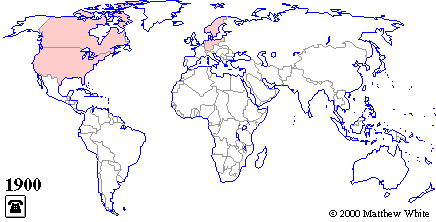Telephones




The telephone is the granddaddy of personal technology. The first commercial phone network went online in 1877, but unlike other early inventions of the Industrial Age such as electric lights and indoor plumbing, the telephone did more than merely improve on some pre-industrial equivalent. It came out of nowhere to fill a need that no one even knew they had until the telephone arrived. Other industrial networks like the telegraph and railroad connected one community with another, but the telephone connected individuals.
I have chosen to map only telephones, because unlike, say, televisions, they've been around since the beginning, and unlike, say, radios, they haven't been superseded by a fancier technology; however, the maps for just about every new technology would look about the same. Most gadgets are more common in the United States than they are in Argentina, and more common in Argentina than they are in Peru. Romania has always been about two notches down from the cutting edge, while India is usually three. In fact, the overall distribution has remained remarkably similar across the entire century, and most of the countries in the top ranks in 1930 are still in the top ranks today.
Last updated February 2000
Copyright © 2000 Matthew White